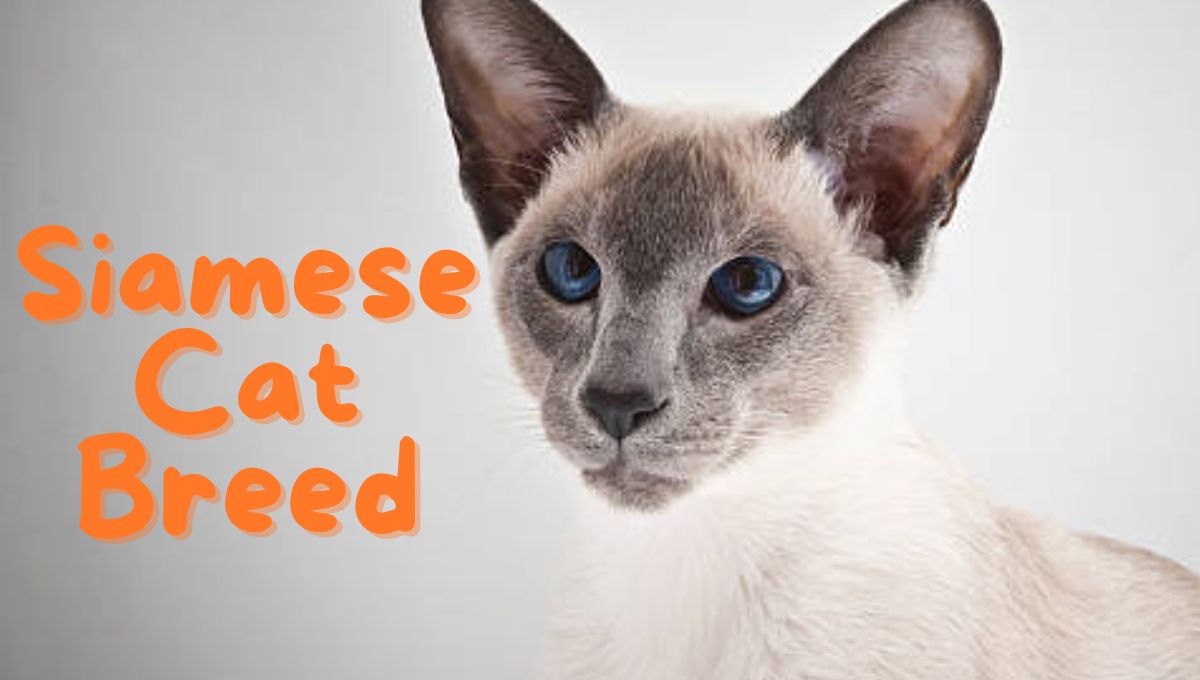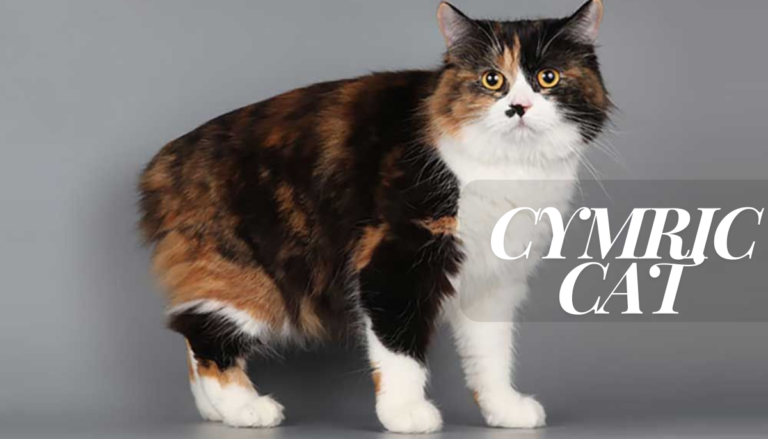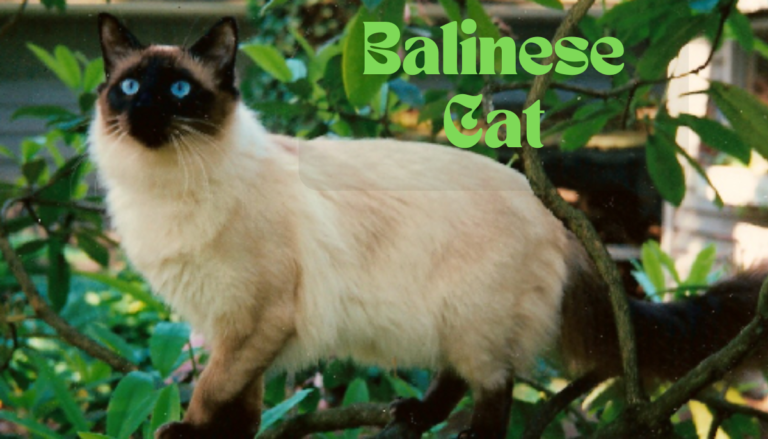Siamese Cat Breed
Introduction :
The Siamese cat is one of the most recognizable and cherished cat breeds, known for its striking appearance and engaging personality. Originating from Thailand, previously known as Siam, these cats have a rich history dating back centuries, often revered in royal courts and temples.
Siamese cats are instantly recognizable due to their sleek, slender bodies, short coats, and striking color points on their ears, face, paws, and tail, which contrast beautifully with their lighter body color. One of their most captivating features is their deep blue, almond-shaped eyes that convey both intelligence and curiosity.
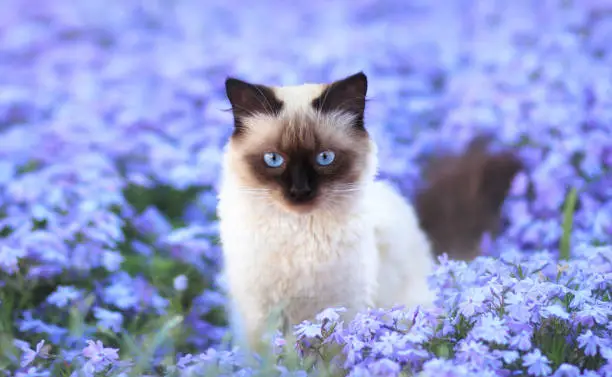
Beyond their beauty, Siamese cats are renowned for their vocal and social nature. They are highly communicative, often engaging in conversations with their owners through a range of vocalizations. These cats are also known for forming strong, loyal bonds with their human companions, displaying affectionate and interactive behavior.
Their intelligence and playful demeanor mean they thrive in environments where they receive ample mental and physical stimulation. Whether it’s through interactive toys, puzzles, or simply spending time with their family, Siamese cats are happiest when they are engaged and entertained. This combination of elegance, intelligence, and affection makes the Siamese cat a beloved companion for those seeking a lively and loving feline friend.
Table of Contents
I. Origin and History of Siamese Cats
The Siamese cat breed is one of the oldest and most recognizable cat breeds in the world, known for its distinctive vocalizations.
Origin :
- Country of Origin: Siam, which is modern-day Thailand.
- Ancient References: The earliest known records of Siamese cats come from manuscripts dating back to the 14th century, such as the Tamra Maew (The Cat-Book Poems).
- Role in Thai Culture: Siamese cats were held in high regard in their native country. They were often associated with royalty and were considered sacred. Some legends suggest they were temple cats and were used to guard Buddhist temples.
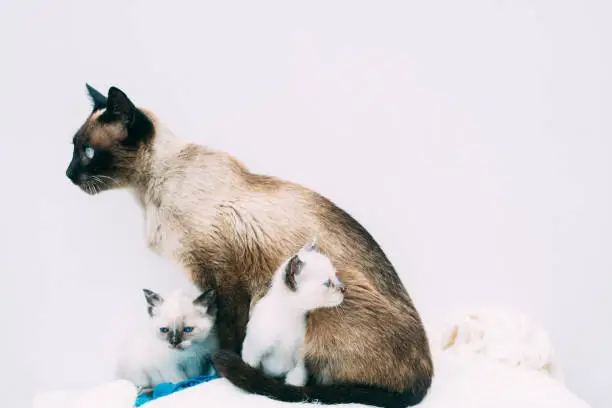
- Late 19th Century: The breed was first brought to the Western world in the late 1800s.
- United Kingdom: The first Siamese cats were reportedly presented to the British royal family in the late 1800s, which helped to popularize the breed in Europe.
- United States: The Siamese cat made its debut in the United States at the end of the 19th century and quickly gained popularity.
History :
- Cultural Icon: The Siamese cat’s unique appearance and vocal nature made it a cultural icon both in Thailand and in Western societies.
- Breed Development: The original “Old-Style” or “Traditional” Siamese had a more rounded body and face. Over time, Western breeders developed the “Modern” Siamese with a more elongated, slender body and a wedge-shaped head.
- Contribution to Cat Breeding: The Siamese cat has contributed to the development of several other breeds, including the Oriental Shorthair, Balinese, and Tonkinese.
- Representation in Media: The breed has been featured in numerous films, books, and other forms of media, contributing to its mystique and popularity.
II. Characteristic of Siamese Cats
| Height | 8 to 10 inches or 20 to 25 centimeters |
| Weight | 6 to 14 pounds or 2.7 to 6.4 kilograms Generally males tend to be heavier, weighing between 8 to 14 pounds (3.6 to 6.4 kg) while female usually weigh between 6 to 10 pounds (2.7 to 4.5 kg) |
| Life Spam | 12 to 15 years |
| Good with | Families: They are great with families, including those with children, due to their playful and interactive nature. Other Pets: Siamese cats often get along well with other pets, including dogs and other cats, especially if introduced properly and socialized from a young age. Singles and Couples: They are also excellent companions for singles and couples, as they form strong bonds with their human companions and enjoy being involved in daily activities. Active Households: Siamese cats are energetic and curious, so they do well in active households where they receive plenty of stimulation and attention. People Who Are Home Often: They are ideal for people who are home frequently, as Siamese cats can be quite vocal and demanding of attention, and they can become lonely or anxious if left alone for long periods. |
| Temperament | Loving and Social companions that can bring joy to their owners’ lives. |
| Intelligence | Highly intelligent and curious creature. |
| Shedding Amount | Their shedding tends to be less compared to long-haired breeds, but they do shed year-round. |
| Grooming | Regular Brushing: While Siamese cats have short coats, they still benefit from regular brushing to remove loose hair and distribute natural oils. Aim to brush your Siamese cat at least once a week using a soft-bristled brush or grooming mitt. Bathing: Siamese cats typically do not require frequent baths unless they get particularly dirty. However, if you do bathe your Siamese cat, use a gentle cat shampoo and warm water, and be sure to thoroughly rinse to avoid leaving any residue on their coat. Nail Trimming: Trim your Siamese cat’s nails regularly to prevent them from becoming too long and causing discomfort or snagging on furniture. Use cat-specific nail clippers and be careful not to cut into the quick, which can cause bleeding and pain. Ear Cleaning: Check your Siamese cat’s ears regularly for dirt, wax buildup, or signs of infection. Use a damp cotton ball or pad to gently clean the outer ear, but avoid inserting anything into the ear canal. Dental Care: Dental health is important for all cats, including Siamese cats. Brush your cat’s teeth regularly with a pet-safe toothbrush and toothpaste to prevent dental issues such as tartar buildup and gum disease. Eye Care: Siamese cats are prone to tearing and eye discharge due to their distinctive facial structure. Use a damp cloth to gently wipe away any discharge from around the eyes, being careful not to touch the eyeball itself. Regular Vet Check-ups: Schedule regular veterinary check-ups for your Siamese cat to monitor their overall health and address any grooming or medical concerns. |
| Exercise needs | Interactive Play: Engage your Siamese cat in daily interactive play sessions using toys such as feather wands, laser pointers, or interactive puzzle toys. These sessions not only provide physical exercise but also mental stimulation. Vertical Space: Siamese cats enjoy climbing and exploring vertical spaces. Provide cat trees, shelves, or perches where they can climb, jump, and observe their surroundings. Toys: Offer a variety of toys to keep your Siamese cat entertained, including balls, catnip toys, and puzzle toys that dispense treats. Rotating toys regularly can help prevent boredom. Playmates: If your Siamese cat gets along with other pets, consider getting them a feline playmate to engage in play and social interaction. Outdoor Enclosures: If you have a safe outdoor space, consider providing a secure outdoor enclosure or “catio” where your Siamese cat can safely enjoy the sights, sounds, and smells of the outdoors. Training: Teach your Siamese cat to perform tricks or participate in agility exercises using positive reinforcement training methods. This not only provides mental stimulation but also strengthens the bond between you and your cat. Rotate Activities: Keep your Siamese cat’s exercise routine varied and interesting by rotating different activities and toys. This prevents them from becoming bored with their routine and encourages them to stay active. |
| Energy Level | High energy level and playful nature |
| Meowing Level | Siamese cats are famously vocal and known for their loud and frequent meowing. They have a wide range of vocalizations, from soft chirps to loud, insistent meows. Siamese cats are highly social and use their vocalizations to communicate with their owners and express their needs, desires, and emotions. They may meow to greet you, ask for attention, or even engage in a conversation with you. Some Siamese cats are more talkative than others, but in general, they are known for their expressive and chatty nature. If you’re considering getting a Siamese cat, be prepared for their vocal tendencies and enjoy the lively conversations they bring to your home. |
| Drool Amount | Not generally heavy droolers |
| Coat length/Texture | short, fine coats that lie close to their bodies. The texture of their fur is soft and sleek with a silky feel to the touch. |
| Colors | Seal Point: Dark brown points on a cream or beige body. Blue Point: Gray-blue points on a bluish-white body. Chocolate Point: Dark brown points on a lighter brown body. Lilac Point: Pinkish-gray points on a pale grayish-white body. |
| Patterns | Tabby Points: Siamese cats with tabby points have a patterned overlay on their darker points, resulting in stripes or swirls. This is known as “lynx” or “tabby” patterning. Tortoiseshell Points: Siamese cats with tortoiseshell points have a mix of two or more colors in their darker points, creating a mottled or marbled appearance. Colorpoint Patterns: Some Siamese cats may have colorpoint patterns with variations in color intensity on their body, such as lighter or darker shading on their torso or legs. |

III. Personality of Siamese Cats :
Siamese cats are known for their distinctive and engaging personalities. Here are some key traits that characterize the Siamese cat breed:
- Affectionate: Siamese cats form strong bonds with their human companions and enjoy being close to them. They are often affectionate and love to cuddle and snuggle with their owners.
- Social: Siamese cats are highly social animals and thrive on interaction with people and other pets. They enjoy being involved in household activities and may follow their owners around the house.
- Vocal: Siamese cats are famously vocal and have a wide range of vocalizations, from soft chirps to loud, insistent meows. They are not shy about expressing their needs and desires through vocal communication.
- Intelligent: Siamese cats are highly intelligent and curious creatures. They enjoy mental stimulation and may engage in problem-solving activities. They can also learn tricks and respond well to training.
- Active: Siamese cats are energetic and playful, even into adulthood. They enjoy interactive play sessions and may even enjoy playing fetch with their favorite toys.
- Loyal: Siamese cats are known for their loyalty to their human family members. They often form strong bonds with their owners and may become distressed if separated from them for long periods.
- Demanding: Siamese cats can be quite demanding of attention and affection. They may vocalize loudly if they feel ignored or if they want something from their owners. They thrive on companionship and may become anxious or lonely if left alone for extended periods.
Overall, Siamese cats are loving, social, and intelligent companions that can bring joy and entertainment to their owners’ lives. Their unique personality traits make them beloved pets for many households.
IV. Care and Maintainance of Siamese Cats :
Taking care of a Siamese cat involves providing for their basic needs as well as meeting their social and mental stimulation requirements. Here’s a guide to care and maintenance for Siamese cats:
- Nutritious Diet: Feed your Siamese cat a balanced and nutritious diet suitable for their age, activity level, and health status. Consult with your veterinarian to determine the best diet for your cat and ensure they have access to fresh water at all times.
- Regular Veterinary Care: Schedule annual check-ups with a veterinarian to monitor your Siamese cat’s health and address any medical concerns. Keep up with vaccinations, parasite prevention, and dental care as recommended by your vet.
- Grooming: Despite their short coat, Siamese cats benefit from regular grooming to remove loose hair and distribute natural oils. Brush your Siamese cat’s coat weekly using a soft-bristled brush or grooming mitt to minimize shedding and prevent matting.
- Dental Care: Maintain your Siamese cat’s dental health by brushing their teeth regularly with a pet-safe toothbrush and toothpaste. Dental problems can lead to serious health issues, so it’s essential to prioritize oral hygiene.
- Environmental Enrichment: Provide your Siamese cat with plenty of opportunities for mental and physical stimulation. Offer interactive toys, climbing structures, and puzzle feeders to keep them entertained and engaged.
- Social Interaction: Siamese cats are social creatures that thrive on companionship. Spend quality time with your cat, engaging in interactive play, cuddling, and bonding activities. Consider getting a feline playmate if your Siamese cat enjoys the company of other cats.
- Training: Use positive reinforcement training techniques to teach your Siamese cat basic commands and behaviors. Training sessions provide mental stimulation and strengthen the bond between you and your cat.
- Safety: Ensure your home environment is safe for your Siamese cat by removing any potential hazards such as toxic plants, small objects that could be swallowed, and open windows or balconies.
- Spaying or Neutering: Consider spaying or neutering your Siamese cat to prevent unwanted litters and reduce the risk of certain health problems.
By providing attentive care and meeting the needs of your Siamese cat, you can ensure they lead a happy, healthy, and fulfilling life as part of your family.
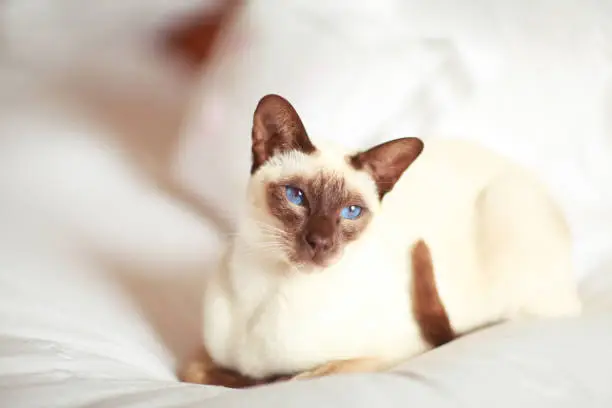
V. Suitability of Siamese Cats :
Siamese cats are generally well-suited for families and can get along well with other pets when introduced properly. Here’s why Siamese cats are often a good fit for families and households with other pets:
- Social Nature: Siamese cats are highly social animals and enjoy being part of a family environment. They thrive on interaction with people and can form strong bonds with their human family members.
- Playful and Energetic: Siamese cats are playful and energetic, making them great companions for children and active families. They enjoy interactive play sessions and can keep up with the energy of kids.
- Lovable: Siamese cats are known for their affectionate nature and love to cuddle and snuggle with their owners. They often seek out attention and enjoy being petted and held.
- Intelligent and Trainable: Siamese cats are highly intelligent and can be trained to perform tricks and behaviors using positive reinforcement methods. This makes them adaptable to various household situations and routines.
- Good with Other Pets: Siamese cats can typically get along well with other pets, including dogs and other cats, especially if they are introduced gradually and given time to acclimate to each other. Their social nature and playful demeanor make them good companions for other animals.
- Vocal Communicators: While Siamese cats are known for their vocalizations, including loud meows and chirps, they can also be effective communicators within a family dynamic, letting their owners know when they want attention or are feeling playful.
Overall, Siamese cats can make wonderful additions to families and households with other pets, providing love, companionship, and entertainment to all members of the family. However, it’s essential to consider each individual cat’s personality and temperament when introducing them to a new environment or other pets. Gradual introductions and positive reinforcement techniques can help ensure a smooth transition and promote harmonious relationships between pets.
VI. Adoption and Breeder consideration of Siamese Cats :
When consider adopting a Siamese Cat, there are several factors to keep in mind, whether you’re adopting from a shelter, rescue organization or breeder.
Adoption from shelters or rescue organizations :
- Rescue Organizations: Look for reputable Siamese cat rescue organizations or breed-specific rescues in your area. These organizations often have Siamese cats available for adoption and can provide information about each cat’s personality and background.
- Shelters: Visit local animal shelters and humane societies to see if they have any Siamese cats available for adoption. Many shelters have cats of all breeds, including Siamese, looking for loving homes.
Research and Visit :
Take the time to research different shelters or rescue organizations in your area and visit them to meet the available cats. Spend time interacting with the cats to get a sense of their personalities and determine which one would be the best fit for your family and lifestyle.
Health and Temperament :
When adopting a Siamese cat, inquire about their health and temperament history. Ask about any medical treatments they may have received and any behavioral assessments that have been conducted. Ensure that the cat is spayed or neutered and up-to-date on vaccinations.
Adoption Fees and Policies :
Be prepared to pay an adoption fee, which often includes vaccinations, spaying/neutering, and other medical care. Familiarize yourself with the shelter or rescue organization’s adoption policies and procedures, including any requirements for home visits or follow-up checks.
Breeder Consideration :
- If you decide to purchase a Siamese cat from a breeder, research reputed breeders who prioritize the health and well-being of their cats.
- Look for breeders who are registered with reputable cat breeding associations and adhere to their codes of ethics and standards.
- Visit the breeder’s facilities in person to see the living conditions of the cats and ensure they are clean, well cared for, and socialized.
- Ask the breeder about the health and genetic history of their cats, including any screening for hereditary diseases common in Siamese cats.
- Be prepared to pay a higher price for a Siamese cat from a reputable breeder, as they often invest in breeding programs aimed at producing healthy, well-socialized kittens.
Whether you choose to adopt from a shelter or rescue organization or purchase from a breeder, the most important thing is to provide a loving and responsible home for your Siamese cat. Consider your family’s lifestyle, preferences, and commitment to providing proper care for the cat throughout its life.

On average you can expect to pay from 30,000 to 40,000 INR for Siamese kittens from breeders while for adoption of Siamese cats from a shelter or rescue organization is more affordable.
VII. Conclusion :
In conclusion, the Siamese cat stands as a timeless symbol of elegance, intelligence, and companionship in the world of feline companions. Originating from ancient Siam, these captivating creatures have enchanted generations with their sleek, slender bodies, stunning blue eyes, and distinctive color points.
Renowned for their vocal nature, Siamese cats are not shy about expressing their thoughts and desires, engaging in lively conversations with their human companions. Their affectionate and social personalities make them ideal companions for families, singles, and seniors alike, forming strong bonds with those who welcome them into their homes.
Whether adopted from a rescue organization, shelter, or chosen from a reputable breeder, Siamese cats bring joy, warmth, and endless entertainment to the lives of their owners. As with any pet, responsible ownership entails providing proper care, love, and attention to ensure their well-being and happiness.
In the hearts of cat enthusiasts worldwide, the Siamese cat remains a cherished and beloved breed, continuing to captivate with its beauty, intelligence, and unwavering devotion.
FAQ about Siamese Cats
Are siamese cats good with children and other pets?
Siamese cats make great family pets. Due to their gentle, playful nature and friendly personality, they get along well with kids, as well as other pets. However, some people don’t like them for their highly vocal nature and noisy habits.
Do siamese cats have any specific dietary needs?
Siamese cats are friendly, loving, and vocal animals. To care for them, feed them a high protein diet. Make sure to brush their teeth regularly and provide them with perches around your house. See a vet regularly and have your cat screened for conditions like heart disease and glaucoma.
What is the life expectancy of siamese cats?
Siamese cats live up to 15 years on average, some can reach 20 years old. People love Siamese cats because they are sociable, playful, and entertaining. It is possible to train Siamese cats due to their intelligent nature. They can be trained to walk on a harness and do lots of tricks.
How much does a siamese cat costs?
The purchase price of a Siamese cat in India can range from 30,000 to 40,000 INR, depending on the source, quality, and location of the cat. The food and nutrition cost of a Siamese cat in India can range from 500 to 2000 INR per month, depending on the type, quality, and quantity of the food.
Do siamese cats need a lot of grooming?
Siamese cats have short, fine fur, so they don’t need a lot of grooming. However, they do shed, so regular brushing is a good idea to keep their coat healthy and reduce shedding. Like any cat breed, they require regular nail trimming and ear cleaning.

